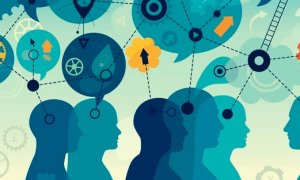Collaborative Intelligence - Think Tanks


Written and verified by the psychologist Valeria Sabater
Collaborative intelligence can be a transforming power for human beings. Think tanks are groups where people can share ideas, thoughts, and approaches with one common purpose: the common good. Many consider that this type of mental investment is what companies, institutions, and any social scenario need most.
Working and thinking together for common goals is inspiring. However, you must admit that achieving them isn’t always easy.
Working as a team, for example, intrinsically presents difficulties and disagreements. Likewise, no one has taught you how to develop a collaborative mentality; how internal resources such as creativity, motivation, and enthusiasm mobilize towards others, achieving a joint harmony where everyone wins.
However, that’s the key to the future. We need smarter companies, as well as groups of people who are able to work together without their egos getting in the way. In other words, without friction and deactivating that rigid thinking that makes you place so many barriers in front of progress and well-being.
Humans are moving forward with an increasingly complex present and future where you need to tune efforts and resources in the same direction. How can you do it? Collaborative intelligence could be the key.
“No one knows everything, everyone knows something, all knowledge resides in humanity.”
-Pierre Levy-

The pillars of collaborative Intelligence
Collective intelligence or collaborative mindset is a topic that has always been of interest to the fields of psychology, sociology, and the world of business. Moreover, the field of biology has been studying this concept for centuries by observing it in the micro-universe of bacteria and, of course, in others that may be closer and more visible to you.
For example, the collective behavior of animals is undoubtedly the most striking of all. Think of those flocks of birds flying in the same direction and always in perfect synchrony. Also visualize a school of fish, the krill swarms, the dolphin groups and of course, those community of ants that make life parallel to yours in any garden, terrace, or park.
What makes all these species symbiotic? Is it mere survival? It’s possible. In fact, Dr. Dawna Markova, an expert in learning, leadership, and talent processes at MIT, points out some things of great relevance that everyone should consider in her book Collaborative Intelligence: Thinking with People Who Think Differently.
Learn to think along with people who think differently
One of the principles of collective intelligence is knowing how to be and knowing how to contribute to an environment where other people think differently. Now, getting it is never easy because, according to Dr. Markova, humans are used to living in the depths of their own individuality.
One could say that people have learned to be more competitive than collaborative (that implies not accepting the opinions of others), which means seeing the other as an enemy to overcome in competition to reach your goals. Where do you get when you act individually and competitively? Obviously nowhere.
Similarly, things change if you take advantage of your talent by adopting a collaborative mindset. Because two minds think better than one. And because, sometimes, when you think differently, you can combine your particular perspective with something bigger, more prodigious and inspiring.
Intellectual diversity, therefore, is allowing your strengths to emerge in a collective setting, where all individual strengths work in harmony.
Align your intention with the intention of others
Talents shared in a common goal allow you to go further. Something as inspiring as aligning your goals with those of others should be your daily motivation.
However, you should be aware that this is very difficult to achieve because there are still many who want to be “the teacher’s pet”, the smartest one, the one who does the most, the one who aspires to reach higher than others, and the one who wants to run everyone over.
Therefore, one of the foundations of collective intelligence is to encourage yourself to change. It’s time to establish the most suitable conditions where this type of competition can develop. Continue reading to find out how.

Keys to collaborative intelligence
José Ortega y Gasset used to say that “Civilization endures if many contribute their collaboration to the effort only. On the other hand, if everyone would much rather enjoy the proceeds, then civilization will sink”. These righteous words are now more relevant than ever because, if there’s something everyone needs in the face of the challenges that come your way, it’s brilliant minds who know how to work collaboratively.
In other words, each one must contribute their own excellence, creativity, experience, and particular vision to the group in order to create a much larger entity oriented towards the same goals: progress and common well-being. However, what are the mechanisms to achieving it? Here are the keys.
- Willingness and motivation to share knowledge and resources.
- Creating both physical and virtual collaborative spaces.
- Knowing how to build adequate trust with others, where there’s no competition, pride, or control.
- The groups must, therefore, be horizontal and not vertical.
- It’s essential to understand the dynamics of a group (knowing how to communicate, solve problems, etc.).
- Always be open to new ideas.
- Have the right tools (physical spaces, training, and also virtual spaces where communication can thrive).
To conclude, attitude is another element that collaborative intelligence needs. A committed attitude towards change, where individualism and group vision weigh much less, of a community that knows how to move towards better progress.
All cited sources were thoroughly reviewed by our team to ensure their quality, reliability, currency, and validity. The bibliography of this article was considered reliable and of academic or scientific accuracy.
- Markova, Dawna (2015) Collaborative Intelligence: Thinking with People Who Think Differently. Spiegel & Grau
- Tapscott, D. y Williams, AD (2008). Cómo la colaboración masiva lo cambia todo EEUU. Penguin Group
This text is provided for informational purposes only and does not replace consultation with a professional. If in doubt, consult your specialist.








